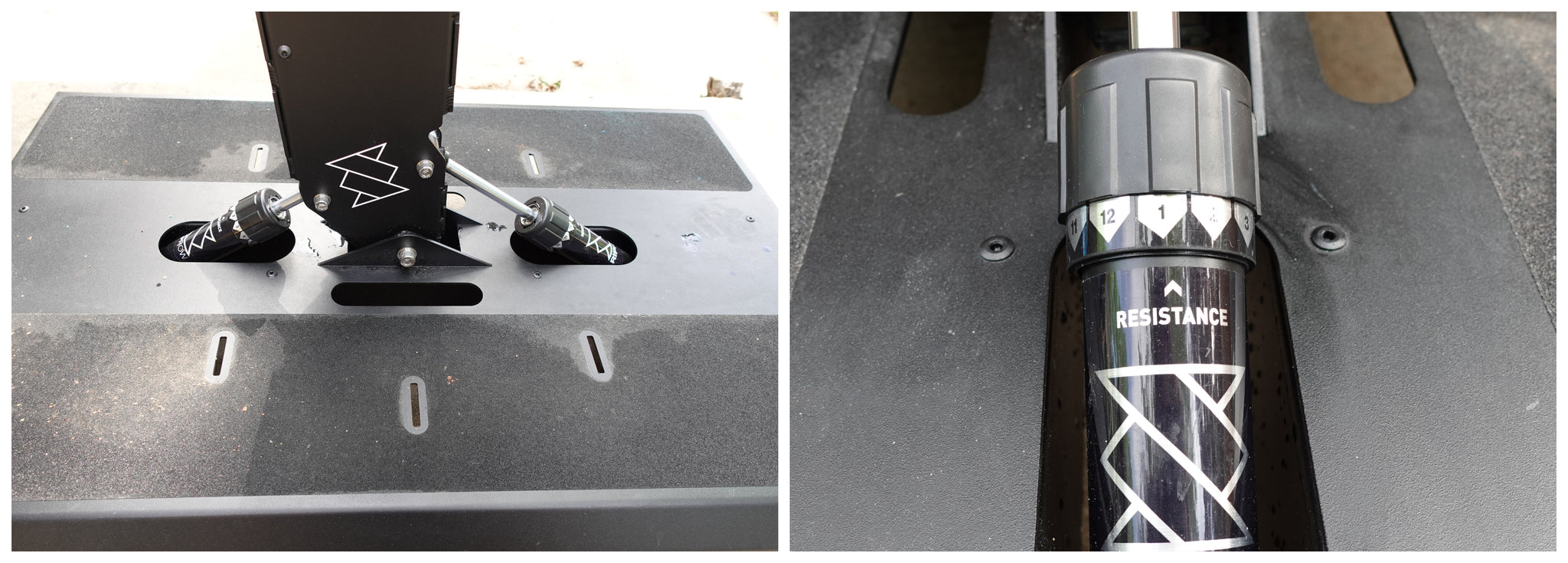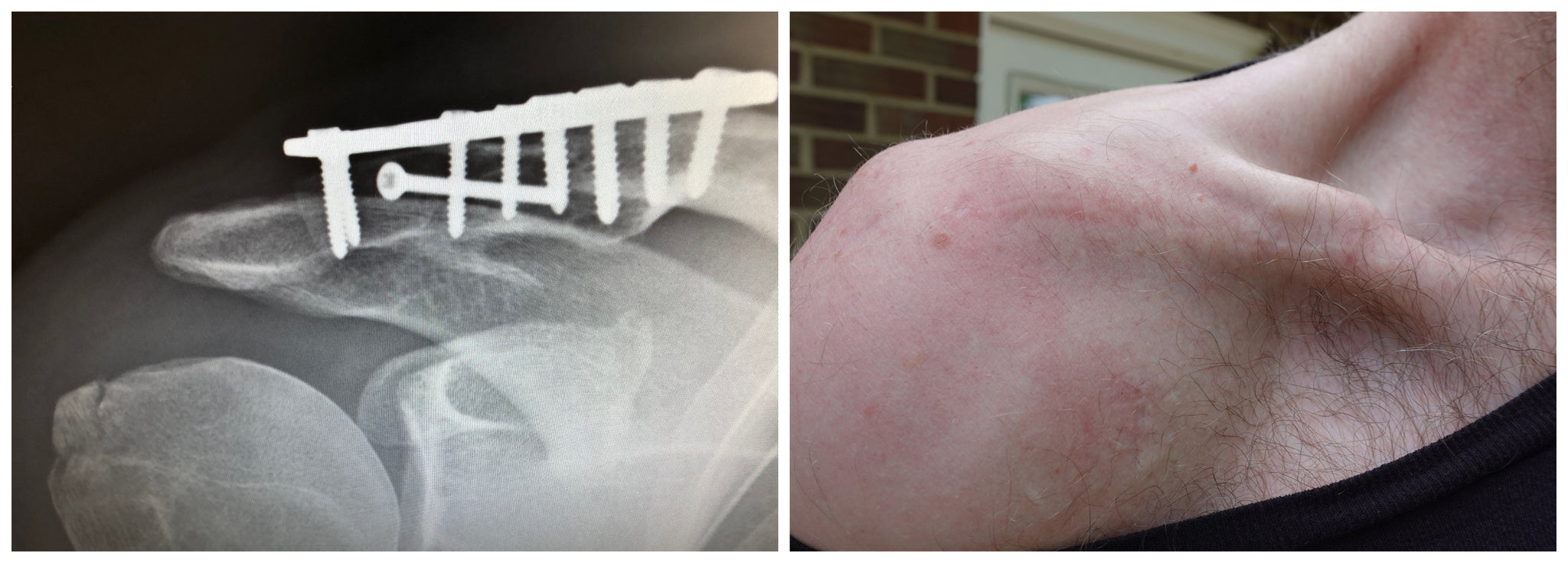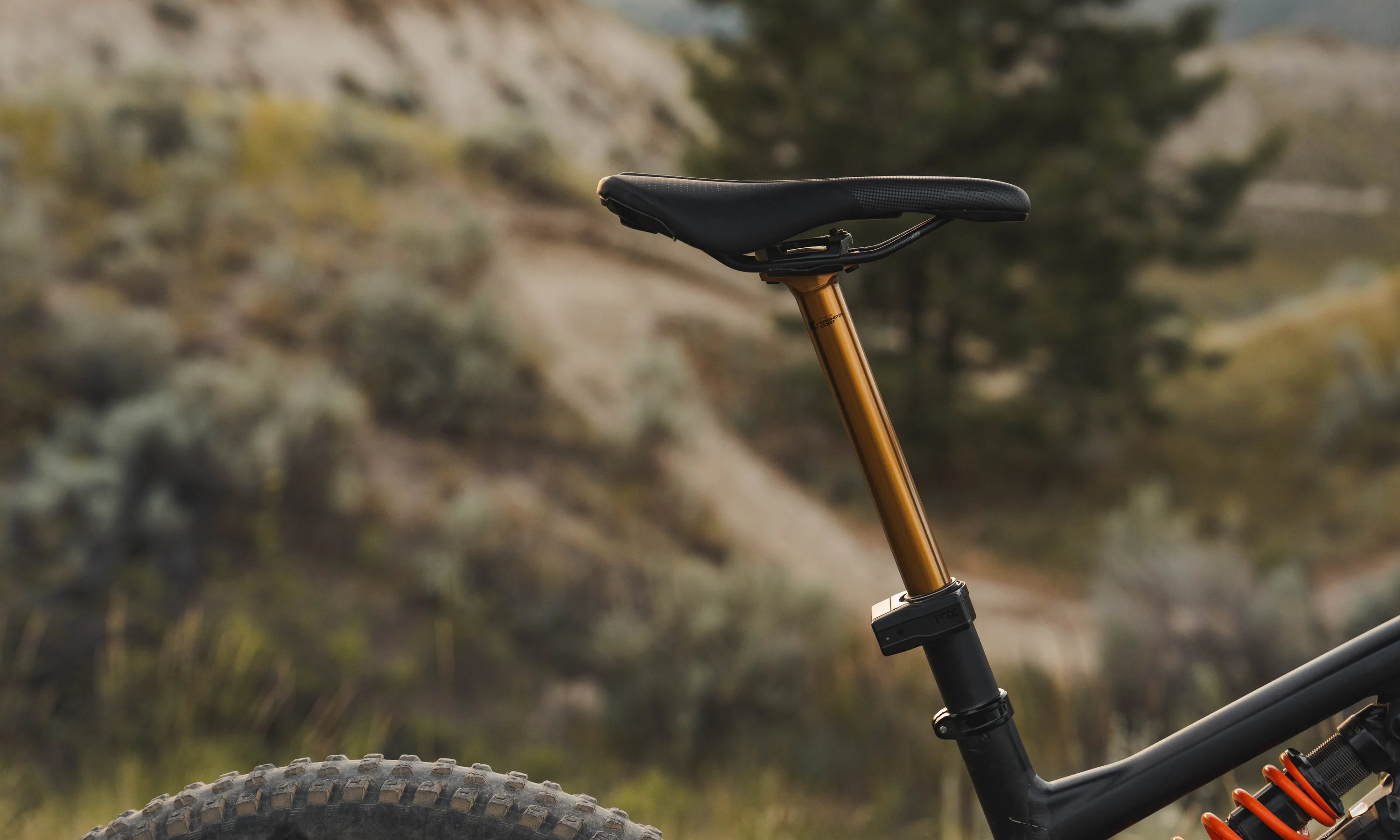Last August, our warehouse manager, Steve Gardner, went down hard riding his mountain bike on a high-speed downhill trail. His front wheel washed out, and like a bearded sledgehammer, he drove his outstretched arm into the ground, turning his shoulder muscles, bones, and tendons into a bowl of spaghetti.
Fortunately, Steve Gardner is a lot like Steve Austin, the Six Million Dollar Man. When he gets broken, he comes back better, stronger, faster. If he gets hurt and can't ride, he knows how to stay motivated and fit. I followed his most recent physical therapy and rehab process through Instagram stories and noticed he was using an interesting new tool: the RipRow.
 What is the RipRow? It’s a bit hard to explain without seeing it in action. It’s a mountain bike-specific exercise machine that acts like a stationary pump track. You have handlebars, adjustable resistance, and a “rocker base” that allow riders to train the fundamental push and pull motions used for pumping and absorbing terrain, while also building balance, coordination, anaerobic fitness, and core stability. Several high-level enduro racers train with the RipRow to build the strength and endurance needed to attack long, tough downhill stages.
What is the RipRow? It’s a bit hard to explain without seeing it in action. It’s a mountain bike-specific exercise machine that acts like a stationary pump track. You have handlebars, adjustable resistance, and a “rocker base” that allow riders to train the fundamental push and pull motions used for pumping and absorbing terrain, while also building balance, coordination, anaerobic fitness, and core stability. Several high-level enduro racers train with the RipRow to build the strength and endurance needed to attack long, tough downhill stages.
 RipRow resistance is adjustable from 1 (easiest) to 12 (hardest).
RipRow resistance is adjustable from 1 (easiest) to 12 (hardest).
The RipRow retails for $1,199.99. That might seem extravagant to some, but if you had a magic tool to help get stronger on the bike, especially after a major injury, wouldn’t it be worth the cost?
To learn more about this curious machine, I sat down with Steve to chat about his injury, the rehab process, and how he used the RipRow to build the fitness he needed to get back on his mountain bike.
The Pro’s Closet: Tell us about your injury. How did it happen? What did you injure?
Steve Gardner: It was the last day of a week-long, 250-mile bikepacking trip to the western edge of the Grand Tetons. A group of us had finished and we unloaded our bikes to spend the last days shuttling Teton Pass trails and riding Grand Targhee resort.
I remember feeling drowsy on the chairlift going into the last run of the day, and I really should have pulled the plug and cruised down the service road. My front wheel found the soft outside edge of a corner and I took a hard, unexpected slam on my outstretched arm. I’ve had dozens of shoulder dislocations over the years and multiple prior surgeries. I could sense that this one was more severe but I tried to play it cool as my friends helped me ease my arm back into the socket. I was gutted but somewhat thankful that it was the last day of the trip.
TPC: What was the prognosis for your injury? How long did you have to stay off the bike?
SG: After a long drive back to Colorado I visited my orthopedic surgeon and immediately scheduled an MRI. The images showed that two rotator cuff muscles were almost 90% torn. One of my bicep tendons had been torn out of its sheath on the humerus, and the humerus itself had a bone fracture flaking off. Also, the glenoid labrum inside the socket had been torn.
 It was indeed much worse than my previous injuries, and I remember the physician’s assistant looking at me sort of incredulously while the surgeon delivered the news. Surgery was scheduled and I started mentally preparing for 6-8 weeks in a sling. After the procedure, the surgeon informed me that I would actually need 10-12 weeks in the sling due to the bicep tenodesis repair. I ended up losing nearly all muscle tone in my dominant arm while letting the tissue heal.
It was indeed much worse than my previous injuries, and I remember the physician’s assistant looking at me sort of incredulously while the surgeon delivered the news. Surgery was scheduled and I started mentally preparing for 6-8 weeks in a sling. After the procedure, the surgeon informed me that I would actually need 10-12 weeks in the sling due to the bicep tenodesis repair. I ended up losing nearly all muscle tone in my dominant arm while letting the tissue heal.
TPC: How did you rehab your injury? What was the process like?
SG: I went through 40 visits with a physical therapist over the course of six months. Most of our time was spent working on my range of motion, basically pushing gently into the pain and forcing the body to accommodate. It was tedious and every degree of movement was hard-fought.
 Fortunately, I found that I was able to use the RipRow on low resistance to ease my arm into the movements I needed to get back on the mountain bike. I also used the machine with my healthy arm to keep the rest of my body moving at a higher intensity. The PT process was a powerful reminder that our bodies adapt to whatever we ask them to do repeatedly, whether that’s sitting down or working out.
Fortunately, I found that I was able to use the RipRow on low resistance to ease my arm into the movements I needed to get back on the mountain bike. I also used the machine with my healthy arm to keep the rest of my body moving at a higher intensity. The PT process was a powerful reminder that our bodies adapt to whatever we ask them to do repeatedly, whether that’s sitting down or working out.
TPC: Why did you buy the RipRow? Was it specifically for rehab or did you have other things in mind?
SG: I had actually purchased the RipRow in April 2020 when the Covid lockdowns closed my gym and the local pump track. The creator of the RipRow, Lee McCormack, had been on my radar with his MTB-focused books and training courses. Though I had always been skeptical about home workout machines, I knew that Lee had a deep understanding of MTB fundamentals and I figured the RipRow would be an interesting way to maintain strength during quarantine. It ended up exceeding my expectations, especially in terms of versatility. I realized that the RipRow could be used to develop strength, cardio, balance, coordination, flexibility, speed, and muscle memory. It was also surprisingly fun to use!
TPC: How do you use your Rip Row?
SG: My volume usually depends on the season and how much cycling I’m doing each week. During the winter months, I shot for three 45 minute workouts per week. As outdoor miles increase, I’ll drop to two 20 minute workouts per week and mix in some yoga.
The RipRow website has some informative videos to help users get familiar with the movements and structuring workouts. A typical workout involves a warmup, some middle-resistance endurance work, high-resistance strength work, and light-resistance speed work.
Sometimes I struggle to get excited for structured workouts, so I turn to POV mountain biking videos on YouTube and “ride” along doing various movements on the RipRow. I started with some of my favorite local trails and eventually worked up to a 20-minute video from Megavalanche in the French Alps. I figured if I could simulate the effort for a 20-minute descent, I would have the stamina for just about any trail in Colorado.
 There are at least 10 different movements that can be done on the RipRow. It all requires balancing on an unstable platform. The root movements are a push-pull with the arms and the hip hinge/deadlift for legs. Maintaining good form through these dynamic movements is extremely challenging for the core as well. In my opinion, performing these movements in a controlled state allows you to train your body for extreme scenarios you can’t safely reach on a pump track or trail.
There are at least 10 different movements that can be done on the RipRow. It all requires balancing on an unstable platform. The root movements are a push-pull with the arms and the hip hinge/deadlift for legs. Maintaining good form through these dynamic movements is extremely challenging for the core as well. In my opinion, performing these movements in a controlled state allows you to train your body for extreme scenarios you can’t safely reach on a pump track or trail.
TPC: Now that you’re mountain biking again, how do you think the Rip Row helped/changed your riding?
SG: Both before and after the injury I’ve found that consistent RipRow training improves my confidence on the trail. By alternating my feet in the forward position I’ve become less dependent on my dominant (forward) riding leg. I’m convinced that RipRow practice has lengthened and strengthened my Hamstrings and resolved chronic knee pain I used to struggle with. I’m also able to practice explosive power moves (like climbing a ledge) and extreme compressions (like rolling off a steep rock) in the safety of my garage. Training the body to perform these movements with strength and speed has unlocked new levels of shred for me, and I find myself emphasizing the distinct RipRow movements while smashing obstacles on the trail.
 I’ve also found myself seeing these same movements when watching videos of my favorite pro riders. From Tahnee Seagrave to Danny MacAskill, I think all pro MTB riders use a combination of the strength, speed, and mobility you can develop on the RipRow to master their respective disciplines. Of course, plenty of riders have achieved greatness without a RipRow. But very few have done so without spending extensive time training key movements in a gym. I bet that some top-level pros are privately using the RipRow as a secret training weapon behind the scenes.
I’ve also found myself seeing these same movements when watching videos of my favorite pro riders. From Tahnee Seagrave to Danny MacAskill, I think all pro MTB riders use a combination of the strength, speed, and mobility you can develop on the RipRow to master their respective disciplines. Of course, plenty of riders have achieved greatness without a RipRow. But very few have done so without spending extensive time training key movements in a gym. I bet that some top-level pros are privately using the RipRow as a secret training weapon behind the scenes.
TPC: So do you plan to keep using the Rip Row after you’re fully recovered?
SG: I’ll continue using my RipRow for as long as I can. So far I’ve been happy with the durability of the unit. I have had to tighten up the main pivot bolts once over the past year. As I alluded to earlier, PT shouldn’t be treated as a one-and-done program. I will always have to work on my shoulders due to my past injuries. And I’ll always need a movement plan to balance out the 40+ hours I spend sitting at a desk each week. Our bodies are exceptionally good at adapting to our routines, and using the RipRow helps build that muscle memory in a convenient way. Having more fun on the bike is the cherry on top, and it is very sweet indeed!
TPC: I’m excited to see you riding gnarly trails again, though I was hoping the time off would have softened you a bit so I can keep up. Looks like that’s not the case.
SG: Haha. Thanks.
 So is the RipRow worth it? For Steve it most certainly was. His comeback has been spectacular. I can tell you from experience, it's pretty surprising when you get dropped by a rider who’s “still recovering” and “just taking it easy.” It’s no wonder Steve was one of the key people I interviewed for our “How to come back from crash or injury” piece a couple of years ago.
So is the RipRow worth it? For Steve it most certainly was. His comeback has been spectacular. I can tell you from experience, it's pretty surprising when you get dropped by a rider who’s “still recovering” and “just taking it easy.” It’s no wonder Steve was one of the key people I interviewed for our “How to come back from crash or injury” piece a couple of years ago.
But is the RipRow worth it to us mere mortals? I’m definitely curious. It costs more than the $300 I spent building my backyard pump track. But unlike a pump track, it requires no digging, is easy to move, takes up little space, doesn’t need constant maintenance, and can be used indoors during the winter.
Doing a minute on the RipRow at medium resistance blasted my whole posterior chain and felt like doing an all-out effort for several laps on the pump track. I’ve lost a lot of fitness since having a baby, and maintaining my backyard pump track has become a bit of a chore, so I just might have to pick up a RipRow for myself!

























